
John Muir
Great Basin Bristlecone Pine




It is a medium-size tree, reaching 5 to 15 m (16 to 49 ft) tall and with a trunk diameter of up to 2.5 to 3.6 m (8 ft 2 in to 11 ft 10 in). The bark is bright orange-yellow, thin and scaly at the base of the trunk. The leaves ('needles') are in fascicles of five, stout, 2.5 to 4 cm (0.98 to 1.57 in) long, deep green to blue-green on the outer face, with stomata confined to a bright white band on the inner surfaces. The leaves show the longest persistence of any plant, with some remaining green for 45 years (Ewers & Schmid 1981).
These ancient trees have a gnarled and stunted appearance, especially those found at high altitudes,[3] and have reddish-brown bark with deep fissures. As the tree ages, much of its vascular cambium layer may die. In very old specimens, often only a narrow strip of living tissue connects the roots to a handful of live branches.
The cones are ovoid-cylindrical, 5 to 10 cm (2.0 to 3.9 in) long and 3 to 4 cm (1.2 to 1.6 in) broad when closed, green or purple at first, ripening orange-buff when 16 months old, with numerous thin, fragile scales, each scale with a bristle-like spine 2 to 5 mm (0.079 to 0.197 in) long. The cones open to 4 to 6 cm (1.6 to 2.4 in) broad when mature, releasing the seeds immediately after opening. The seeds are 5 mm (0.20 in) long, with a 12 to 22 mm (0.47 to 0.87 in) wing; they are mostly dispersed by the wind, but some are also dispersed by Clark's nutcrackers.
The tree is extremely vulnerable to fire, and is damaged by even low-intensity burns. The resinous bark is capable of igniting quickly, and a crown fire will almost certainly kill the tree. However, populations of Pinus longaeva are known to be extremely resilient, and as a primary succession species, it is believed that populations of the tree would reestablish itself quickly after a fire. That said, large-scale fires are extremely uncommon where the species grows, and are not a major factor in the species' long-term viability.
A specimen of this species, located in the White Mountains of California was measured by Tom Harlan to be 5,062 years old in 2012.[4] The identity of the specimen is being kept secret by Harlan.[9] This is the oldest known tree in North America, and the oldest known individual tree in the world, although a clonal individual, nicknamed "Old Tjikko", a Norway spruce in Sweden is 9,550 years old.
The previously oldest named specimen of this species, "Methuselah", is also located in the Ancient Bristlecone Pine Forest of the White Mountains. Methuselah is 4,844 years old, as measured by annual ring count on a small core taken with an increment borer. Its exact location is also kept secret.
Among the White Mountain specimens, the oldest trees are found on north-facing slopes, with an average of 2,000 years, as compared to the 1,000 year average on the southern slopes. The climate and the durability of their wood can preserve them long after death, with dead trees as old as 7,000 years persisting next to live ones.[
Sourced:
https://en.wikipedia.org/wiki/Pinus_longaeva#cite_note-FEIS-3

Engelmann Spruce

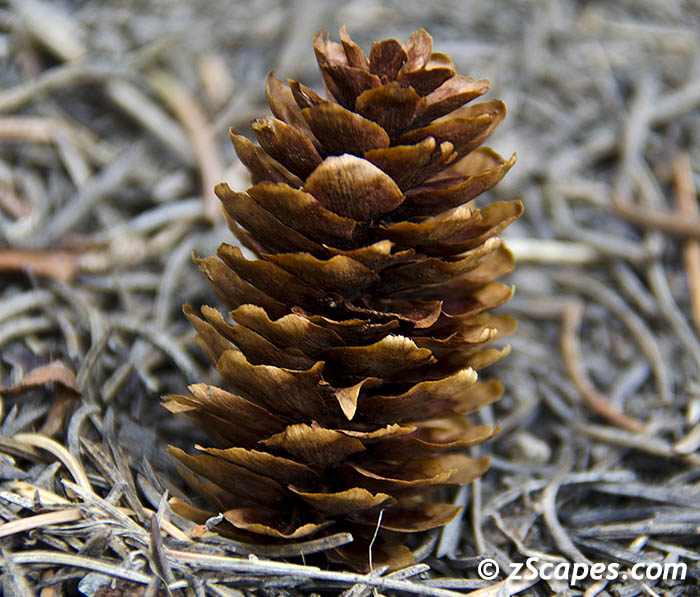

The Picea Engelmannii is commonly known as Columbian Spruce, Engelmann Spruce, Mountain Spruce, Pino Real, Silver Spruce, as well as White Spruce.
Large tree with dark or blue-green foliage and a dense, narrow, conical crown of short branches spreading in close rows. Engelmann’s spruce is a narrow, spire-like evergreen, growing 75-100 ft. tall. Its branches descend to sweep the ground and conceal the trunk. The coniferous needles are dark blue-green.
Its resonant qualities make the wood of Engelmann Spruce valuable for piano sounding boards and violins. This species was named after George Engelmann (1809-84), the German-born physician and botanist of St. Louis and authority on conifers.
The species of this plant is named for George Engelmann (1809-1884) who was born in Germany and settled in St. Louis, Missouri, as a young man. He was a physician and botanist, describing especially North American Abies (Firs), Agaves, Cactus (for which he described more than 108 species), Cuscuta (Dodder), Euphorbiaceae (Spurge Family), Juncus (Rushes), Juniperus (“Cedar”), Pinus (Pines), Vitis (Grapes), and Yuccas. When he died much of his collection went to Missouri Botanical Garden.
Engelmann spruce is of economic importance for its wood, harvested for paper-making and general construction. Wood from slow-grown trees at high altitude has a specialised use in making musical instruments such as acoustic guitars, harps, violins, and pianos. It is also used to a small extent as a Christmas tree.
Soruced:
http://www.treesofnorthamerica.net/trees/Engelmann+Spruce
http://www.wildflower.org/plants/result.php?id_plant=PIEN
https://en.wikipedia.org/wiki/Picea_engelmannii
Large tree with dark or blue-green foliage and a dense, narrow, conical crown of short branches spreading in close rows. Engelmann’s spruce is a narrow, spire-like evergreen, growing 75-100 ft. tall. Its branches descend to sweep the ground and conceal the trunk. The coniferous needles are dark blue-green.
Its resonant qualities make the wood of Engelmann Spruce valuable for piano sounding boards and violins. This species was named after George Engelmann (1809-84), the German-born physician and botanist of St. Louis and authority on conifers.
The species of this plant is named for George Engelmann (1809-1884) who was born in Germany and settled in St. Louis, Missouri, as a young man. He was a physician and botanist, describing especially North American Abies (Firs), Agaves, Cactus (for which he described more than 108 species), Cuscuta (Dodder), Euphorbiaceae (Spurge Family), Juncus (Rushes), Juniperus (“Cedar”), Pinus (Pines), Vitis (Grapes), and Yuccas. When he died much of his collection went to Missouri Botanical Garden.
Engelmann spruce is of economic importance for its wood, harvested for paper-making and general construction. Wood from slow-grown trees at high altitude has a specialised use in making musical instruments such as acoustic guitars, harps, violins, and pianos. It is also used to a small extent as a Christmas tree.
Soruced:
http://www.treesofnorthamerica.net/trees/Engelmann+Spruce
http://www.wildflower.org/plants/result.php?id_plant=PIEN
https://en.wikipedia.org/wiki/Picea_engelmannii
Fremont's Silk Tassle

The plant is native to the West coast of the United States, from Washington to California. It can be found in a number of habitats, from mountain forest to woodlands and chaparral canyons and slopes.
Garrya fremontii is a shrub reaching a maximum height of three to four meters. The leaves are oval-shaped, 2 to 12 centimeters long and about half as wide, and smooth green, rarely with hairs on the undersides. The plant is dioecious, with male and female plants producing long, hanging clusters of yellowish to pinkish flowers. The fruit is a spherical berry, starting green and turning pink and then purple. The fruit is eaten by birds and mammals, who disperse the seeds. The plant can also sprout from its root crown. Like many other chaparral species, it is quick to recover from wildfire.
Sourced:
https://en.wikipedia.org/wiki/Garrya_fremontii
http://www.calflora.org/cgi-bin/species_query.cgi?where-calrecnum=3750

Giant Sequoia


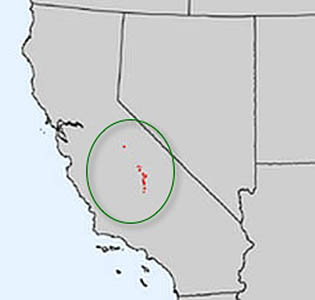
The Sequoiadendron Giganteum is commonly known as Bigtree, as well as Giant Sequoia.
The giant-sequoia is a massive evergreen tree, maturing to 250 ft. high with a girth of 80 ft. Bluish-green needles are crowded and spirally arranged on the twigs. The fluted trunk and red-brown bark are attractive landscape features, revealed as the tree loses its lower branches. The tree retains a narrow, pyramidal crown of foliage in the upper reaches at maturity. One of the world’s largest trees with fibrous, reddish-brown trunk much enlarged and buttressed at base, fluted into ridges, and conspicuously narrowed or tapered above; narrow, conical crown of short, stout, horizontal branches reaches nearly to base. Giant trees have tall, bare trunk and irregular, open crown.
This rare species ranks among the worlds oldest trees; felled trees show annual rings indicating up to 3200 years of age. Almost all Giant Sequoias are protected in Yosemite, Kings Canyon, and Sequoia national parks, in 4 national forests, and in state parks and forests. It is a popular, large ornamental tree in moist, cool temperate climates along the Pacific Coast and around the world. The lumber is no longer used, although many trees were cut and wasted in the early logging days. Seedlings and saplings are killed by forest fires, but the very thick bark of mature trees offers resistance. Douglas squirrels cut and store quantities of mature cones, and sparrows, finches, and chipmunks destroy many seedlings.
Wood from mature giant sequoias is highly resistant to decay, but due to being fibrous and brittle, it is generally unsuitable for construction. From the 1880s through the 1920s, logging took place in many groves in spite of marginal commercial returns. The Hume-Bennett Lumber Company was the last to harvest giant sequoia, going out of business in 1924.[12] Due to their weight and brittleness, trees would often shatter when they hit the ground, wasting much of the wood. Loggers attempted to cushion the impact by digging trenches and filling them with branches. Still, as little as 50% of the timber is estimated to have made it from groves to the mill. The wood was used mainly for shingles and fence posts, or even for matchsticks.
Pictures of the once majestic trees broken and abandoned in formerly pristine groves, and the thought of the giants put to such modest use, spurred the public outcry that caused most of the groves to be preserved as protected land. The public can visit an example of 1880s clear-cutting at Big Stump Grove near General Grant Grove. As late as the 1980s, some immature trees were logged in Sequoia National Forest, publicity of which helped lead to the creation of Giant Sequoia National Monument.
Sourced:
http://www.treesofnorthamerica.net/trees/Giant+Sequoia
http://www.wildflower.org/plants/result.php?id_plant=SEGI2
https://en.wikipedia.org/wiki/Sequoiadendron_giganteum
The giant-sequoia is a massive evergreen tree, maturing to 250 ft. high with a girth of 80 ft. Bluish-green needles are crowded and spirally arranged on the twigs. The fluted trunk and red-brown bark are attractive landscape features, revealed as the tree loses its lower branches. The tree retains a narrow, pyramidal crown of foliage in the upper reaches at maturity. One of the world’s largest trees with fibrous, reddish-brown trunk much enlarged and buttressed at base, fluted into ridges, and conspicuously narrowed or tapered above; narrow, conical crown of short, stout, horizontal branches reaches nearly to base. Giant trees have tall, bare trunk and irregular, open crown.
This rare species ranks among the worlds oldest trees; felled trees show annual rings indicating up to 3200 years of age. Almost all Giant Sequoias are protected in Yosemite, Kings Canyon, and Sequoia national parks, in 4 national forests, and in state parks and forests. It is a popular, large ornamental tree in moist, cool temperate climates along the Pacific Coast and around the world. The lumber is no longer used, although many trees were cut and wasted in the early logging days. Seedlings and saplings are killed by forest fires, but the very thick bark of mature trees offers resistance. Douglas squirrels cut and store quantities of mature cones, and sparrows, finches, and chipmunks destroy many seedlings.
Wood from mature giant sequoias is highly resistant to decay, but due to being fibrous and brittle, it is generally unsuitable for construction. From the 1880s through the 1920s, logging took place in many groves in spite of marginal commercial returns. The Hume-Bennett Lumber Company was the last to harvest giant sequoia, going out of business in 1924.[12] Due to their weight and brittleness, trees would often shatter when they hit the ground, wasting much of the wood. Loggers attempted to cushion the impact by digging trenches and filling them with branches. Still, as little as 50% of the timber is estimated to have made it from groves to the mill. The wood was used mainly for shingles and fence posts, or even for matchsticks.
Pictures of the once majestic trees broken and abandoned in formerly pristine groves, and the thought of the giants put to such modest use, spurred the public outcry that caused most of the groves to be preserved as protected land. The public can visit an example of 1880s clear-cutting at Big Stump Grove near General Grant Grove. As late as the 1980s, some immature trees were logged in Sequoia National Forest, publicity of which helped lead to the creation of Giant Sequoia National Monument.
Sourced:
http://www.treesofnorthamerica.net/trees/Giant+Sequoia
http://www.wildflower.org/plants/result.php?id_plant=SEGI2
https://en.wikipedia.org/wiki/Sequoiadendron_giganteum

Incense Cedar
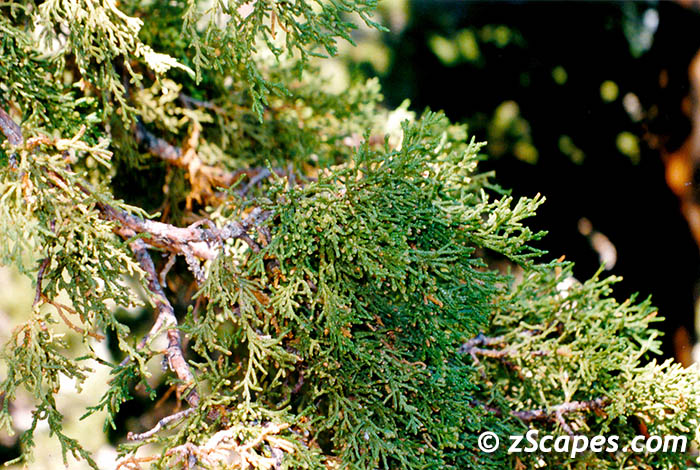


The Calocedrus Decurrens is commonly known as Incense-cedar.
Incense-cedar is a majestic, evergreen tree with flat sprays of aromatic, bright-green foliage, a conical crown, a straight trunk, and cinnamon-brown bark. Though is usually does not exceed 60 ft. in cultivation, specimens in the wild can be twice as tall. Although stands of young trees are killed by fire, the very thick bark protects mature trees.
Incense-cedar is generally found from the southern slope of Mount Hood, Oregon, southward through the Siskiyou, Klamath, and Warner mountains, Cascade and Coast ranges, and from the Sierra Nevada to the Hanson Laguna and Sierra de San Pedro Martir ranges in Baja, California. Incense-cedar is most common in the Sierra Nevada, occurring individually or in small groups
Use Medicinal: Leaves decocted to treat stomach ailments, steamed to treat nasal congestion and colds.
Use Other: An important timber species, Incense Cedar is also the leading wood for the manufacture of pencils, because it is soft but not splintery, and can be sharpened in any direction with ease. The aromatic wood is also used for cedar chests and closets.
Incense cedar was the preferred hearth board of the Native Peoples of Northern California for lighting fires by friction
Sourced
http://www.treesofnorthamerica.net/trees/Incense-cedar
http://www.wildflower.org/plants/result.php?id_plant=CADE27
https://en.wikipedia.org/wiki/Calocedrus
Incense-cedar is a majestic, evergreen tree with flat sprays of aromatic, bright-green foliage, a conical crown, a straight trunk, and cinnamon-brown bark. Though is usually does not exceed 60 ft. in cultivation, specimens in the wild can be twice as tall. Although stands of young trees are killed by fire, the very thick bark protects mature trees.
Incense-cedar is generally found from the southern slope of Mount Hood, Oregon, southward through the Siskiyou, Klamath, and Warner mountains, Cascade and Coast ranges, and from the Sierra Nevada to the Hanson Laguna and Sierra de San Pedro Martir ranges in Baja, California. Incense-cedar is most common in the Sierra Nevada, occurring individually or in small groups
Use Medicinal: Leaves decocted to treat stomach ailments, steamed to treat nasal congestion and colds.
Use Other: An important timber species, Incense Cedar is also the leading wood for the manufacture of pencils, because it is soft but not splintery, and can be sharpened in any direction with ease. The aromatic wood is also used for cedar chests and closets.
Incense cedar was the preferred hearth board of the Native Peoples of Northern California for lighting fires by friction
Sourced
http://www.treesofnorthamerica.net/trees/Incense-cedar
http://www.wildflower.org/plants/result.php?id_plant=CADE27
https://en.wikipedia.org/wiki/Calocedrus

Jeffrey Pine




Jeffery pine has blue-green, twisted needles, 7-9 in. long. Grows from 40-90 ft. with a pyramidal, open crown. Old trees are devoid of branches for more than 1/2 of their height. Cinnamon-brown to yellow-orange, flaky bark. Cones are 6-9 in. long. Large tree with straight axis and open, conical crown of spreading branches and with large cones. Both bark and twigs give off odor of lemon or vanilla when crushed.
The odor of crushed twigs defies exact description. The scent has been likened not only to lemons and vanilla, but also to violets, pineapples, and apples. This species was named for its discoverer, John Jeffrey, the 19th century Scottish botanical explorer who collected seeds and plants in Oregon and California for introduction into Scotland.
Jeffrey pine wood is similar to ponderosa pine wood, and is used for the same purposes. The exceptional purity of n-heptane distilled from Jeffrey pine resin led to n-heptane being selected as the zero point on the octane rating scale of petrol.
As it mainly consists of n-heptane, Jeffrey pine resin is a poor source of turpentine. Before Jeffrey pine was distinguished from ponderosa pine as a distinct species in 1853, resin distillers operating in its range suffered a number of 'inexplicable' explosions during distillation, now known to have been caused by the unwitting use of Jeffrey pine resin.
Sourced:
http://www.treesofnorthamerica.net/trees/Jeffrey+Pine
http://www.wildflower.org/plants/result.php?id_plant=PIJE
https://en.wikipedia.org/wiki/Jeffrey_pine
Monterey Pine

P. radiata is a coniferous evergreen tree growing to 15–30 m (50–100 ft) tall in the wild, but up to 60 m (200 ft) in cultivation in optimum conditions, with upward pointing branches and a rounded top. The leaves ("needles") are bright green, in clusters of three (two in var. binata), slender, 8–15 cm (3–6 in) long and with a blunt tip. The ovulate cones are 7–17 cm (3–6+1⁄2 in) long, brown, ovoid (egg-shaped), and usually set asymmetrically on a branch, attached at an oblique angle. The bark is fissured and dark grey to brown. When not cut short by disease or harvesting, it has a lifespan of 80 to 90 years.
In the United States, it is native to three very limited areas located in Santa Cruz, Monterey, and San Luis Obispo Counties of California. Monterey Pine is one of the world's most valuable pines and is the most common commercially planted one in the southern hemisphere (where pines are not native), especially in New Zealand, Australia, Chile, and South Africa. Like those of Knobcone and Bishop pines, the cones of Monterey Pine remain closed until opened by the heat of a forest fire; the abundant seeds are then discharged and begin a new forest. The cones may also burst open in hot weather with a snapping sound.
Sourced:
https://en.wikipedia.org/wiki/Pinus_radiata
https://www.wildflower.org/plants/result.php?id_plant=PIRA2
Mountain Dogwood



Cornus nuttallii (Pacific dogwood, mountain dogwood, Western dogwood, or California dogwood) is a species of dogwood native to western North America from the lowlands of southern British Columbia to the mountains of southern California, with an inland population in central Idaho. Cultivated examples are found as far north as Haida Gwaii. It is a small to medium-sized deciduous tree, reaching 10–25 m tall.
Tree with dense, conical or rounded crown of often horizontal branches and with beautiful white flower clusters. This is the west coast edition of Cornus florida. It is a 15-40 ft., single- or multi-trunked tree or shrub with a spreading crown and large, showy, creamy white blossoms sometimes flushed with pink. Graceful, horizontal-tiered branching; orange to red fruits; and yellow-orange, fall foliage are other landscape attributes. Pacific flowering dogwood is deciduous.
Pacific Dogwood is one of the most handsome native ornamental trees on the Pacific Coast, with very showy flowers and fruit. The head of flowers with surrounding, petal-like bracts resembles a huge flower and is commonly so called. The flower is larger than that of the eastern Flowering Dogwood (Cornus florida L.), usually having 6 bracts instead of 4. John James Audubon (1780-1851), the American ornithologist and artist, who painted this tree in his famous work Birds of America, named it for its collector, Thomas Nuttall (1786-1859), the British-American botanist and ornithologist.
The genus cornus is Latin for a horn.
Soruced:
http://www.wildflower.org/plants/result.php?id_plant=CONU4
https://en.wikipedia.org/wiki/Cornus_nuttallii
Tree with dense, conical or rounded crown of often horizontal branches and with beautiful white flower clusters. This is the west coast edition of Cornus florida. It is a 15-40 ft., single- or multi-trunked tree or shrub with a spreading crown and large, showy, creamy white blossoms sometimes flushed with pink. Graceful, horizontal-tiered branching; orange to red fruits; and yellow-orange, fall foliage are other landscape attributes. Pacific flowering dogwood is deciduous.
Pacific Dogwood is one of the most handsome native ornamental trees on the Pacific Coast, with very showy flowers and fruit. The head of flowers with surrounding, petal-like bracts resembles a huge flower and is commonly so called. The flower is larger than that of the eastern Flowering Dogwood (Cornus florida L.), usually having 6 bracts instead of 4. John James Audubon (1780-1851), the American ornithologist and artist, who painted this tree in his famous work Birds of America, named it for its collector, Thomas Nuttall (1786-1859), the British-American botanist and ornithologist.
The genus cornus is Latin for a horn.
Soruced:
http://www.wildflower.org/plants/result.php?id_plant=CONU4
https://en.wikipedia.org/wiki/Cornus_nuttallii

Mountain Hemlock
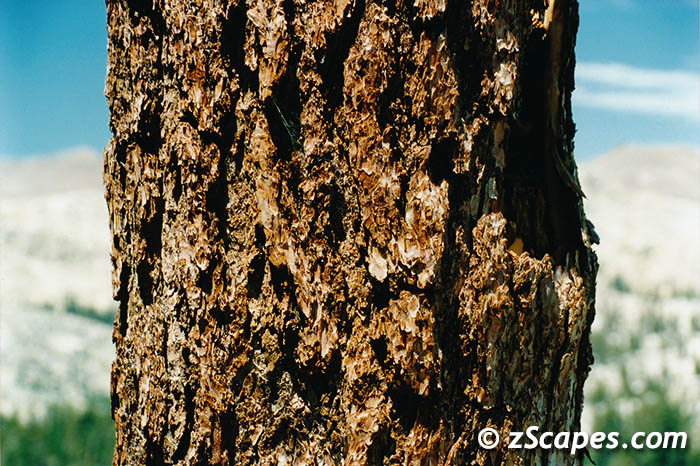
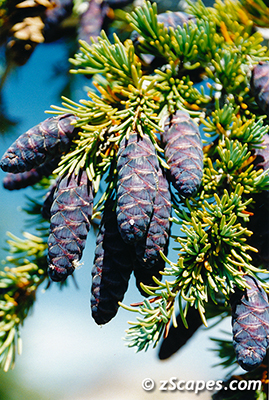


Mountain hemlock, an evergreen tree, grows 15-150 ft. tall in the wild, but is usually 20-60 ft. in cultivation. It has red-brown, scaly bark, and a slender, pyramidal to irregular crown. The central leader is the most droopy of all hemlocks, often making a 180 degree bend and pointing at the ground. Slim branchlets form graceful, pendent masses of delicate foliage. Needles are atypically round and are swept forward adding to the slender appearance of the branches. Cones are closed for most of their life and range in color from brilliant purple to lime-green or red. Tree with tapering trunk, conical crown of slender horizontal or drooping branches, and very slender, curved, drooping leader; a prostrate shrub at timberline.
Mountain Hemlock is a characteristic species of high mountains, varying greatly in size from a large tree at low altitudes to a dwarf, creeping shrub at timberline. Hemlock groves provide cover, nesting sites, and seeds for birds, as well as foliage for mountain goats and other hoofed browsers. This species honors its discoverer, Karl H. Mertens (1796-1830), the German naturalist.
Sourced:
http://www.treesofnorthamerica.net/trees/Mountain+Hemlock
http://www.wildflower.org/plants/result.php?id_plant=TSME
https://en.wikipedia.org/wiki/Tsuga_mertensiana

Mountain Maple (Torrey)

Description
Acer glabrum is a small tree growing to 6–9 metres (20–30 feet) tall, exceptionally 12 m (39 ft), with a trunk around 13 centimetres (5 inches) in diameter, exceptionally around 25 cm (10 in). The leaves are 2–13 cm (3⁄4–5 in) broad, three-lobed (rarely five-lobed), variable in the depth of lobing, occasionally so deeply lobed as to be divided into three leaflets; the lobes have an acute apex and a coarsely serrated margin. The flowers are produced in corymbs of five to ten, yellowish-green, at the same time as the new leaves in spring. The fruit is a samara or winged seed, which develops in fused pairs at an angle of less than 45° when mature, though some varieties spread out to 90°.
Distribution and habitat
Acer glabrum is plentiful in many parts of the Rocky Mountains, Cascade Mountains, Olympic Mountains and the Sierra Nevada, often growing with ponderosa pine, Douglas-fir, and quaking aspen. It can be found in dry rocky areas.
Ecology
It tends to be found in brush fields arising from fire-disturbed sites. Conifers tend to replace it in well-forested areas. The foliage is browsed by game animals (especially deer and elk in winter), cattle, and sheep.
Uses
Native Americans utilized the strong stems for snowshoe frames, bows, and other applications. Some Plateau Indian tribes drink an infusion of Douglas maple as a treatment for diarrhea. Ramah Navajo use an infusion of the glabrum variety for swellings, and also as a "life medicine", or panacea.
https://en.wikipedia.org/wiki/Acer_glabrum
Pinemat Manzanita

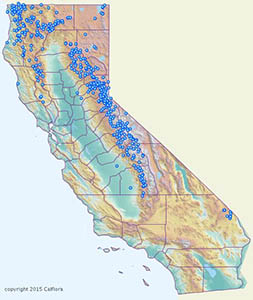
A low-growing ground cover with dark-green, evergreen foliage, red stems and pendulous, pale-pink, spring flowers. The shrub grows 10-18 in. high and spreads 3-5 ft. by means of freely rooting from the intricately branched stems.
Arctostaphylos nevadensis is native to western North America from Washington to California, where it grows in the coniferous forests of the inland and coastal mountain ranges. It is a dominant shrub in the mountain understory chaparral in many areas.
This species is cultivated as a chaparral landscaping plant and it is used to stabilize soil against erosion on mountain slopes
BENEFIT
Use Food: Indigenous Californians used the berries to make a cider-like drink.
Attracts: Birds
Sourced:
http://www.wildflower.org/plants/result.php?id_plant=ARNE
https://en.wikipedia.org/wiki/Arctostaphylos_nevadensis
http://www.calflora.org/cgi-bin/species_query.cgi?where-calrecnum=586
Arctostaphylos nevadensis is native to western North America from Washington to California, where it grows in the coniferous forests of the inland and coastal mountain ranges. It is a dominant shrub in the mountain understory chaparral in many areas.
This species is cultivated as a chaparral landscaping plant and it is used to stabilize soil against erosion on mountain slopes
BENEFIT
Use Food: Indigenous Californians used the berries to make a cider-like drink.
Attracts: Birds
Sourced:
http://www.wildflower.org/plants/result.php?id_plant=ARNE
https://en.wikipedia.org/wiki/Arctostaphylos_nevadensis
http://www.calflora.org/cgi-bin/species_query.cgi?where-calrecnum=586

Ponderosa Pine




Ponderosa pine grows 60-150 ft. in cultivation (as much as 258 ft. in the wild) with a pyramidal, open crown. Old trees are devoid of branches for more than 1/2 of their height. Branches are short and pendulous, often turned up at the ends. Bark is cinnamon-brown to yellow-orange and flaky. Dark, gray-green to yellowish-green needles are long and occur in tufts of two or three at the ends of the twigs. Large to very large tree with broad, open, conical crown of spreading branches; 3 distinct geographic varieties.
This is the most widely distributed and common pine in North America. The typical variety, Ponderosa Pine or Pacific Ponderosa Pine (var. ponderosa), has long needles, 3 in a bundle, and large cones, and occurs in the Pacific Coast region. Rocky Mountain Ponderosa Pine or Interior Ponderosa Pine (var. scopulorum Engelm.) with short needles, 2 in a bundle, and small cones, is found in the Rocky Mountain region. Arizona Pine or Arizona Ponderosa Pine (var. arizonica (Engelm.) Shaw), occurring mainly in southeastern Arizona, has 5 slender needles in bundle. David Douglas, the Scottish botanical explorer, found this pine in 1826 and named it for its ponderous, or heavy, wood. This valuable timber tree is the most commercially important western pine. Its lumber is especially suited for window frames and panel doors. Quail, nutcrackers, squirrels, and many other kinds of wildlife consume the seeds; and chipmunks store them in their caches, thus aiding dispersal.
Sourced:
http://www.treesofnorthamerica.net/trees/Ponderosa+Pine
http://www.wildflower.org/plants/result.php?id_plant=PIPOaliquet egestas vitae, nibh ante quis quis dolor sed mauris. Erat lectus sem ut lobortis, adipiscing ligula eleifend, sodales fringilla mattis dui nuponderosa-rangemapllam. Ac massa aliquet.

Quaking Aspen



The Populus Tremuloides is commonly known as Aspen, Quaking Aspen, as well as Trembling Aspen
A tall, fast growing tree, usually 20–25 m (66–82 ft) at maturity, with a trunk 20–80 cm (0.66–2.62 ft) in diameter; records are 36.5 m (120 ft) in height and 1.37 m (4.5 ft) in diameter.
The bark is relatively smooth, colored greenish-white to gray, and is marked by thick black horizontal scars and prominent black knots. Parallel vertical scars are tell-tale signs of elk, which strip off aspen bark with their front teeth.
The leaves on mature trees are nearly round, 4–8 centimeters (1.6–3.1 in) in diameter with small rounded teeth, and a 3–7 centimeters (1.2–2.8 in) long, flattened petiole. Young trees (including root sprouts) have much larger—10–20 centimeters (3.9–7.9 in) long—nearly triangular leaves.
The flowers are catkins 4–6 centimeters (1.6–2.4 in) long, produced in early spring before the leaves; it is dioecious, with male and female catkins on different trees. The fruit is a 10-centimeter-long (3.9 in) pendulous string of 6-millimeter (0.24 in) capsules, each capsule containing about ten minute seeds embedded in cottony fluff, which aids wind dispersal of the seeds when they are mature in early summer.
The quaking aspen is the State Tree of Utah.
The names refer to the leaves, which in the slightest breeze tremble on their flattened leafstalks. The soft smooth bark is sometimes marked by bear claws. A pioneer tree after fires and logging and on abandoned fields, it is short-lived and replaced by conifers. Sometimes planted as an ornamental. Principal uses of the wood include pulpwood, boxes, furniture parts, matches, excelsior, and particle-board. The twigs and foliage are browsed by deer, elk, and moose, also by sheep and goats. Beavers, rabbits, and other mammals eat the bark, foliage, and buds, and grouse and quail feed on the winter buds.
Soruced:
http://www.treesofnorthamerica.net/trees/Quaking+Aspen
http://www.wildflower.org/plants/result.php?id_plant=POTR5
https://en.wikipedia.org/wiki/Populus_tremuloides
A tall, fast growing tree, usually 20–25 m (66–82 ft) at maturity, with a trunk 20–80 cm (0.66–2.62 ft) in diameter; records are 36.5 m (120 ft) in height and 1.37 m (4.5 ft) in diameter.
The bark is relatively smooth, colored greenish-white to gray, and is marked by thick black horizontal scars and prominent black knots. Parallel vertical scars are tell-tale signs of elk, which strip off aspen bark with their front teeth.
The leaves on mature trees are nearly round, 4–8 centimeters (1.6–3.1 in) in diameter with small rounded teeth, and a 3–7 centimeters (1.2–2.8 in) long, flattened petiole. Young trees (including root sprouts) have much larger—10–20 centimeters (3.9–7.9 in) long—nearly triangular leaves.
The flowers are catkins 4–6 centimeters (1.6–2.4 in) long, produced in early spring before the leaves; it is dioecious, with male and female catkins on different trees. The fruit is a 10-centimeter-long (3.9 in) pendulous string of 6-millimeter (0.24 in) capsules, each capsule containing about ten minute seeds embedded in cottony fluff, which aids wind dispersal of the seeds when they are mature in early summer.
The quaking aspen is the State Tree of Utah.
The names refer to the leaves, which in the slightest breeze tremble on their flattened leafstalks. The soft smooth bark is sometimes marked by bear claws. A pioneer tree after fires and logging and on abandoned fields, it is short-lived and replaced by conifers. Sometimes planted as an ornamental. Principal uses of the wood include pulpwood, boxes, furniture parts, matches, excelsior, and particle-board. The twigs and foliage are browsed by deer, elk, and moose, also by sheep and goats. Beavers, rabbits, and other mammals eat the bark, foliage, and buds, and grouse and quail feed on the winter buds.
Soruced:
http://www.treesofnorthamerica.net/trees/Quaking+Aspen
http://www.wildflower.org/plants/result.php?id_plant=POTR5
https://en.wikipedia.org/wiki/Populus_tremuloides

Sierra Juniper



Western Juniper is common at high altitudes in the Sierra Nevada. Giants reach a trunk diameter of 16 (5 m) and an estimated age of more than 2000 years. This species may develop thick, long roots that entwine rock outcrops, mimicking the shape of the branches
The Juniperus occidentalis shoots are of moderate thickness among junipers, 1-1.6 mm diameter. The leaves are arranged in opposite decussate pairs or whorls of three; the adult leaves are scale-like, 1–2 mm long (to 5 mm on lead shoots) and 1-1.5 mm broad. The juvenile leaves (on young seedlings only) are needle-like, 5–10 mm long. The cones are berry-like, 5–10 mm in diameter, blue-brown with a whitish waxy bloom, and contain one to three seeds; they are mature in about 18 months. The male cones are 2–4 mm long, and shed their pollen in early spring.
The cones are an important food for several birds, including American robin, Clark's nutcracker, phainopepla and cedar waxwing; these digest the fleshy cone scales and disperse the seeds in their droppings. The plants often bear galls caused by the juniper tip midge Oligotrophus betheli (Bibionomorpha: Cecidomyiidae); these are violet-purple fading to brown, 1–2 cm diameter, with dense modified spreading scale-leaves 6–10 mm long and 2–3 mm broad at the base.
There are two Juniperus occidentalis varieties, treated as subspecies by some botanists:
Juniperus occidentalis var. occidentalis Western Juniper. Southeast Washington, eastern and central Oregon, southwest Idaho, northeastern California and extreme northwest Nevada, north of 40° 30' N latitude, east of the Cascade Range. A shrub or small tree 4–15 m tall. Exceptionally tall specimens can be found in the John Day area of Oregon well in excess of 26–28 m tall (80–90 feet+) competing for sunlight among ponderosa pines at the bottom of some deep side canyons, but on open and barren ground 4–15 m with a bushier growth habit is more common. Cones 7–10 mm diameter. About 50% of plants are monoecious with both sexes on the same plant, 50% dioecious, producing cones of only one sex.
Juniperus occidentalis var. australis Sierra juniper. California and westernmost Nevada, south of 40° 30' N latitude in the Sierra Nevada and San Bernardino Mountains. A medium-sized tree 12–26 m tall with a stout trunk up to 3 m diameter. Cones 5–9 mm diameter. Most plants dioecious, but about 5-10% are monoecious.
The Bennett Juniper in the Stanislaus National Forest of California is considered the oldest and largest example at possibly 3000 years old, with a height of 26 m and a diameter of 3.88 m.
Sourced:
https://en.wikipedia.org/wiki/Juniperus_occidentalis
http://www.wildflower.org/plants/result.php?id_plant=JUOC
The Juniperus occidentalis shoots are of moderate thickness among junipers, 1-1.6 mm diameter. The leaves are arranged in opposite decussate pairs or whorls of three; the adult leaves are scale-like, 1–2 mm long (to 5 mm on lead shoots) and 1-1.5 mm broad. The juvenile leaves (on young seedlings only) are needle-like, 5–10 mm long. The cones are berry-like, 5–10 mm in diameter, blue-brown with a whitish waxy bloom, and contain one to three seeds; they are mature in about 18 months. The male cones are 2–4 mm long, and shed their pollen in early spring.
The cones are an important food for several birds, including American robin, Clark's nutcracker, phainopepla and cedar waxwing; these digest the fleshy cone scales and disperse the seeds in their droppings. The plants often bear galls caused by the juniper tip midge Oligotrophus betheli (Bibionomorpha: Cecidomyiidae); these are violet-purple fading to brown, 1–2 cm diameter, with dense modified spreading scale-leaves 6–10 mm long and 2–3 mm broad at the base.
There are two Juniperus occidentalis varieties, treated as subspecies by some botanists:
Juniperus occidentalis var. occidentalis Western Juniper. Southeast Washington, eastern and central Oregon, southwest Idaho, northeastern California and extreme northwest Nevada, north of 40° 30' N latitude, east of the Cascade Range. A shrub or small tree 4–15 m tall. Exceptionally tall specimens can be found in the John Day area of Oregon well in excess of 26–28 m tall (80–90 feet+) competing for sunlight among ponderosa pines at the bottom of some deep side canyons, but on open and barren ground 4–15 m with a bushier growth habit is more common. Cones 7–10 mm diameter. About 50% of plants are monoecious with both sexes on the same plant, 50% dioecious, producing cones of only one sex.
Juniperus occidentalis var. australis Sierra juniper. California and westernmost Nevada, south of 40° 30' N latitude in the Sierra Nevada and San Bernardino Mountains. A medium-sized tree 12–26 m tall with a stout trunk up to 3 m diameter. Cones 5–9 mm diameter. Most plants dioecious, but about 5-10% are monoecious.
The Bennett Juniper in the Stanislaus National Forest of California is considered the oldest and largest example at possibly 3000 years old, with a height of 26 m and a diameter of 3.88 m.
Sourced:
https://en.wikipedia.org/wiki/Juniperus_occidentalis
http://www.wildflower.org/plants/result.php?id_plant=JUOC

Sierra Lodgepole Pine




Sierra Lodgepole Pine (Pinus contorta var. murrayana (Grev. & Balf.) Engelm.), of the Cascade Mountains of southwestern Washington and western Oregon, the Sierra Nevada of central California, south to northern Baja California, is a tall (70-80 ft.), narrow tree with thin, scaly bark; relatively broad, yellowish green to dark green needles that are twisted; and symmetrical, lightweight cones opening at maturity and shedding within a few years. It is a variety of Pinus contorta. It can take several years for the cones to reach maturity and open. The crown will be especially narrow if the tree is growing in crowded, forest conditions. With more space, the crown will enlarge and appear heavier and more open and spreading.
Native American tipis
Lodgepole pine is named for its common use as structural poles for the Native American tipi shelter. A typical tipi is constructed using 15 to 18 pines. The long, straight, and lightweight characteristics of the species made it ideal for horse transport in nomadic Plains buffalo hunting cultures. Tribes made long journeys across the Great Plains to secure lodgepole pines that only grew in mountainous areas. In Minnesota, other species such as red pine would be used in tipis, though they were generally thicker, heavier, and more cumbersome to transport than Pinus contorta.
Pinus contorta is still used by many today for erecting tipis on American Indian reservations, at powwows, and at private homes. The trees may be harvested for tipi poles in U.S. National Forests, provided the harvester secured a permit to cut living trees for ceremonial or traditional purposes. The Bighorn Mountains, the Black Hills, and the Medicine Bow Mountains are popular tipi pole harvesting areas for Native Americans living on Plains Indians reservations in North and South Dakota, and immigrant tipi enthusiasts.
Medicinal
The indigenous peoples of the Pacific Northwest and of California used different parts of the plant internally and externally as a traditional medicine for various ailments.
Sourced:
http://www.treesofnorthamerica.net/trees/Sierra+Lodgepole+Pine
http://www.wildflower.org/plants/result.php?id_plant=PICOM
https://en.wikipedia.org/wiki/Pinus_contorta
Western Redbud

It is easily recognized when it is in bloom from March to May, when it is covered with small pink to purple flowers.
Cercis occidentalis has thin, shiny brown branches that bear shiny heart-shaped leaves which are light green early in the season and darken as they age. Leaves on plants at higher elevation may turn gold or red as the weather cools.
The showy flowers are bright pink or magenta, and grow in clusters all over the shrub, making the plant very colorful and noticeable in the landscape. The shrub bears 3-inch-long brown legume pods which are very thin and dry
Indigenous Californians use the twigs of the western redbud to weave baskets, and even prune the shrub to encourage growth of new twigs. The bark provides a faint reddish dye for the finished basketry. The Concow tribe calls the tree dop (Konkow language or tal'k.
Sourced:
https://en.wikipedia.org/wiki/Cercis_occidentalis
Whiteleaf Manzanita

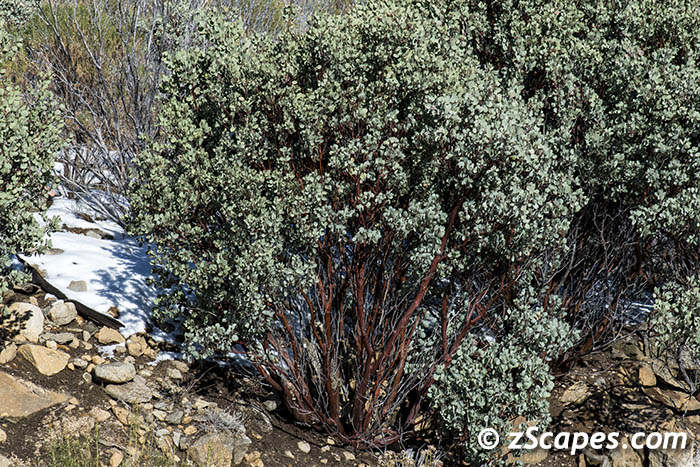

This manzanita is an erect, 6-12 ft., evergreen shrub, with long, crooked branches and smooth, dark, red-brown bark. Leaves are bright green and the inflorescences of white or pink, bell-shaped flowers are drooping. Berries are white at first, later becoming deep red. Large evergreen shrub, sometimes a small tree commonly branching near base, with stout, crooked, twisted trunks and branches and dense, rounded crown as broad as high.
Whether manzanitas should be considered trees is debatable; a few of the approximately 40 native shrubby species mainly in California (including this one) reach tree size. However, they generally branch or fork near the ground, thus lacking the single trunk of a tree. Manzanita is a Spanish word meaning little apple. The mealy berries are consumed in great quantities by wildlife of many kinds and were eaten by Indians, who also made them into manzanita cider. The dense evergreen foliage provides shelter for birds and small mammals; deer and goats browse the leaves and twigs. The handsome reddish-brown branches become twisted into odd shapes which are trimmed into collectors items called mountain driftwood.
BENEFIT
Use Food: Manzanita berries were used to make a refreshing, cider-like drink by indigenous peoples.
Use Other: Wood used today to make driftwood decorative pieces and by indigenous peoples to make fire drills.
Interesting Foliage: yes
Attracts: Birds
Nectar Source: yes
Sourced:
http://www.wildflower.org/plants/result.php?id_plant=ARMA
Whether manzanitas should be considered trees is debatable; a few of the approximately 40 native shrubby species mainly in California (including this one) reach tree size. However, they generally branch or fork near the ground, thus lacking the single trunk of a tree. Manzanita is a Spanish word meaning little apple. The mealy berries are consumed in great quantities by wildlife of many kinds and were eaten by Indians, who also made them into manzanita cider. The dense evergreen foliage provides shelter for birds and small mammals; deer and goats browse the leaves and twigs. The handsome reddish-brown branches become twisted into odd shapes which are trimmed into collectors items called mountain driftwood.
BENEFIT
Use Food: Manzanita berries were used to make a refreshing, cider-like drink by indigenous peoples.
Use Other: Wood used today to make driftwood decorative pieces and by indigenous peoples to make fire drills.
Interesting Foliage: yes
Attracts: Birds
Nectar Source: yes
Sourced:
http://www.wildflower.org/plants/result.php?id_plant=ARMA
May our paths & errands meet
Copyright © 1990-2024 zScapes. All rights reserved






































